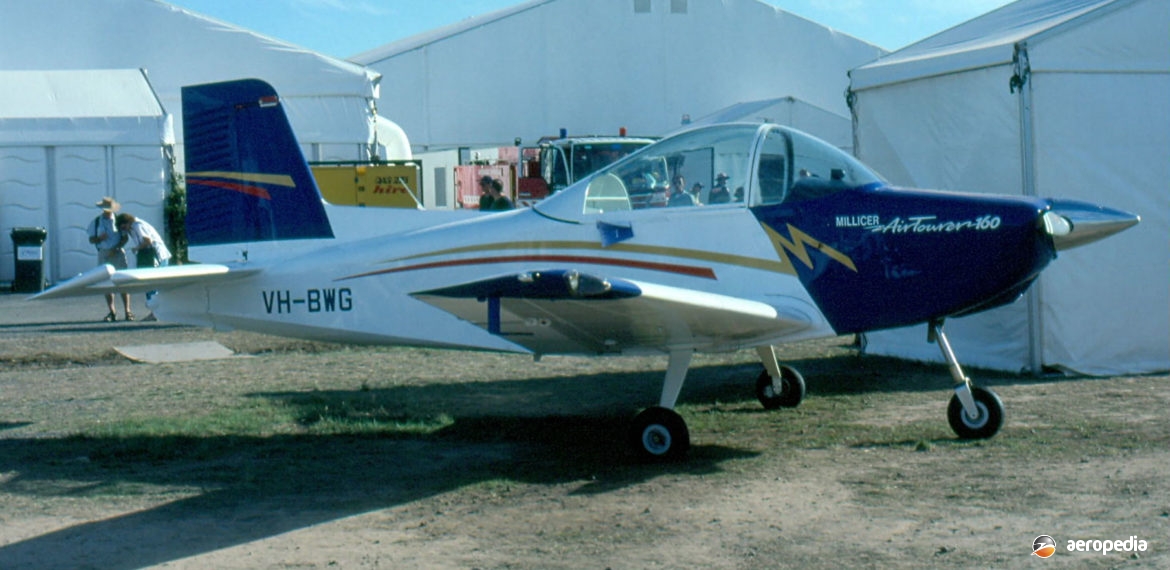Photograph:
Millicer M-10-160 Airtourer VH-BWG (c/n 25) at Avalon, VIC in February 1999 (David C Eyre)
Country of origin:
Australia
Description:
two-seat touring and training aircraft
Power Plant:
One 119 kw (160 hp) Lycoming IO-320-D1A four-cylinder horizontally-opposed air-cooled engine
Specifications:
- Wingspan: 7.92 m (26 ft)
- Length: 6.55 m (21 ft 6 in)
- Height: 2.22 m (7 ft 4 in)
- Wing area: 11.15 m² (120 sq ft)
- Cruising speed at 2,590 m (8,500 ft) at 75% power: 250 km/h (155 mph)
- Rate of climb: 320 m/min (1020 ft/min)
- Stalling speed with 15 degree flap: 90 km/h (56 mph)
- Empty weight: 580 kg (1,278 lb)
- Loaded weight: 862 kg (1,900 lb)
History:
In the late 1990s Millicer Aircraft Industries obtained rights to build the Airtourer, originally built by Victa at Milperra in Sydney, NSW and later built in New Zealand by AESL. Considerable development took place to the design, with a new series of engines, a constant speed propeller, all new undercarriage, aerodynamic cowl, electric flaps, larger fuel tanks, new electrical system, electrical elevator trim, simplified fuselage structure for ease of manufacture, revised engine cowling, Cleveland wheels and brakes, removal of the centre belly flap, more range and a higher airspeed.
Initial proposals were for the Millicer Airtourer to be produced in two models; the M10-140 and the M10-160, the former having the 104 kw (140 hp) Lycoming O-320-E2A engine driving a Sensenich fixed-pitch propeller, and the latter with the 119 kw (160 hp) Lycoming IO-320-D1A unit. The aim was, after production was underway, to move on to the four-seat variant initially known as the Millicer Shrike, the name being changed later to Millicer Aircruiser. The M-10 Airtourer was aerobatic and limits were +6, -3 G. Fuel capacity was 170 litres (37 Imp gals) and baggage allowance was 45 kg (100 lb).
The prototype of the new series, being a conversion of an Airtourer 100 (c/n 25 – ex VH-MVE), the M10-160 VH-BWG (c/n 25) flew on 28 August 1998. After some test flying it was sold and subsequently operated in Sydney. However, it appears on the official civil aircraft register as a Victa Airtourer 100 (c/n 25). In recent years this aircraft has been based at Bathurst, NSW. A further conversion was made of an Airtourer 100 (c/n 75), this being an M10-140, becoming VH-MUJ.
After the prototype was built expectations were that the type would commence production in 1998, the first new-build aircraft off the line to be completed in April 1999, and six aircraft were expected to be delivered during 1999. However, the Company ran into financial troubles and production was shelved, the production of the four-seat variant, the Shrike, also being shelved at that time, and no further aircraft have been completed.
Henry Millicer during his time with Millicer Aircraft Industries was involved in designing and developing a number of other designs. These included the Millicer Kite, Swift and Shrike, the latter referred to above; the Miltrainer 375T with a Garrett TPE 331-1-151 turboprop; and the Miltrainer 330T with an Allison 250 turboprop, the latter two being aimed at providing a future training aircraft for the RAAF. However, none of these designs were ever built.

